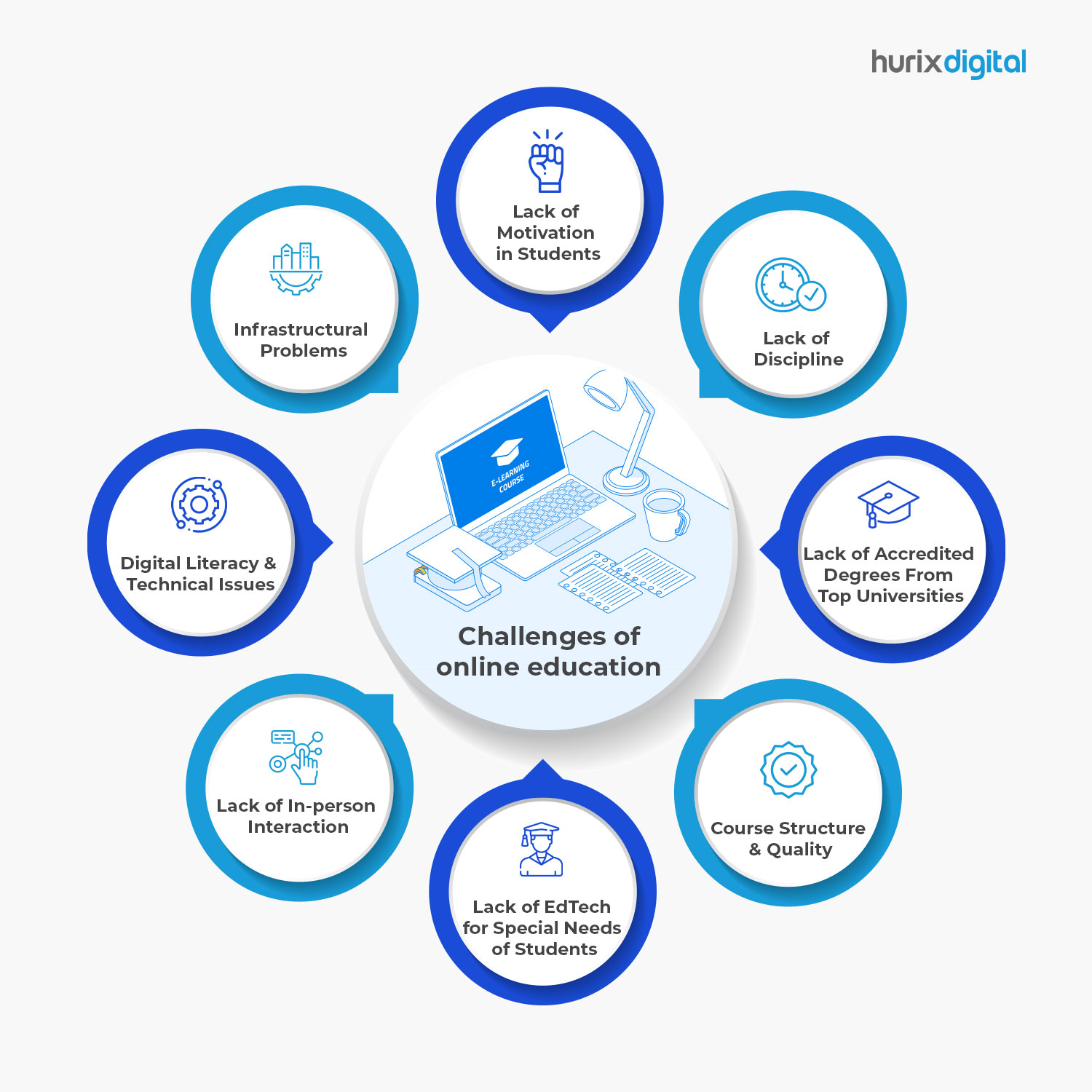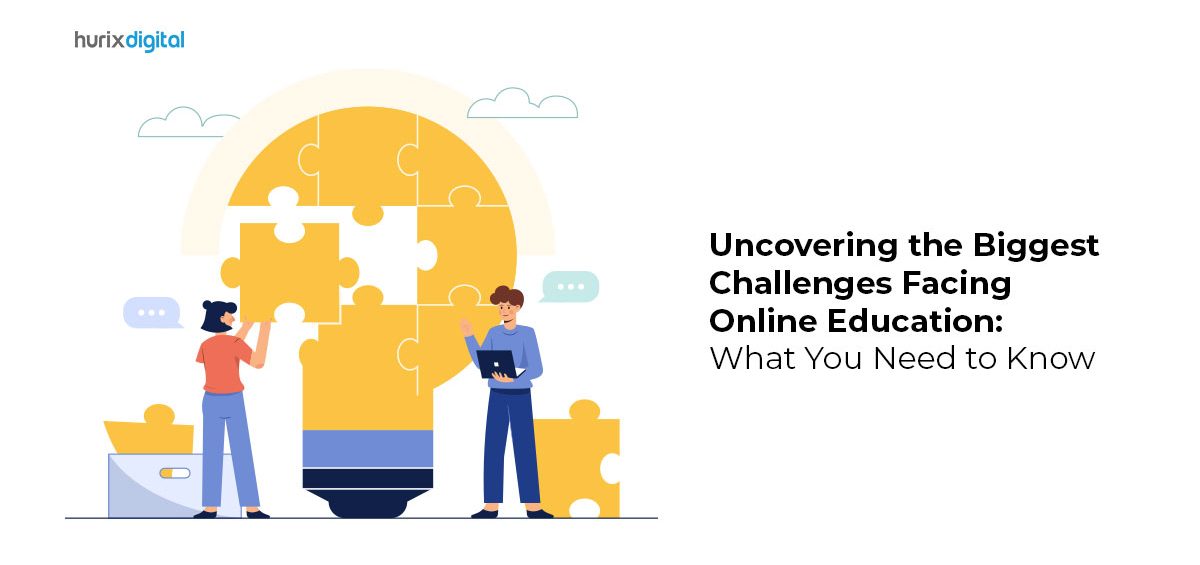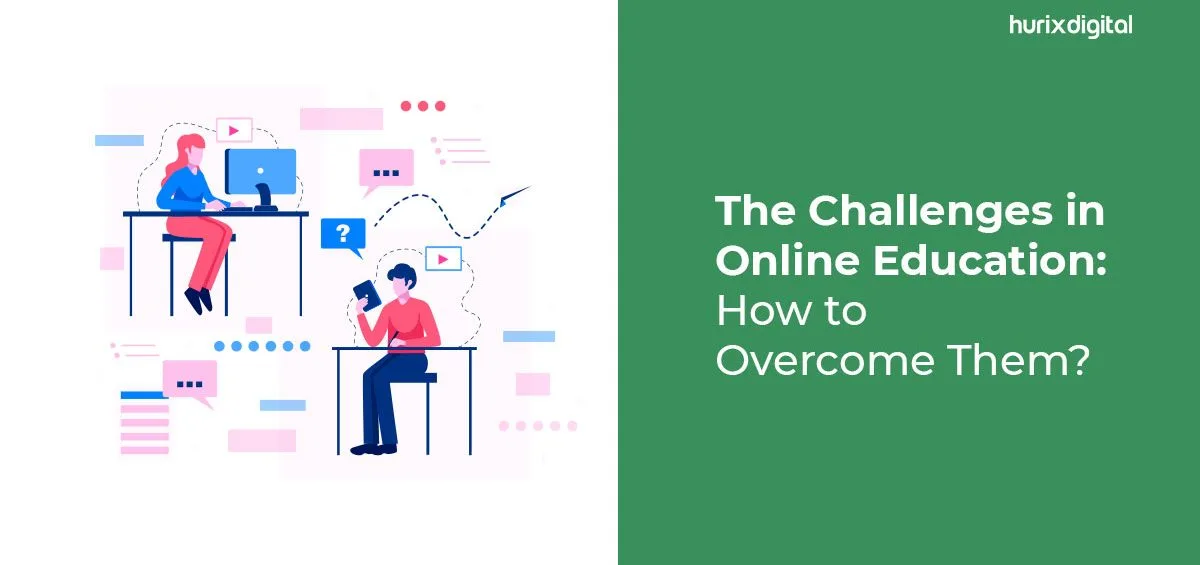The education industry was one of the worst hit by the COVID-19 pandemic, with institutions scrambling to find solutions to keep their doors open. In these times of need, online learning tools emerged as a boon. In the last two years, investments in EdTech tools, especially in the online education segment, have skyrocketed, resulting in significant technological improvements.
Table of Contents:
- Introduction
- What are the Top 10 Key Challenges of Online Education in 2023 & How to Overcome Them?
1. Lack of Motivation in Students
2. Infrastructural Problems
3. Digital Literacy and Technical Issues
4. Lack of In-person Interaction
5. Lack of EdTech and Online Learning Options for Special Needs of Students
6. Course Structure and Quality
7. Lack of Accredited Degrees From Top Universities
8. Abundant Distractions, Lack of Discipline
9. Financial Hurdles
10. Acceptance by Teachers - Conclusion
- Frequently Asked Questions (FAQs)
Introduction
Online education has many benefits such as portability, ease of access, reduced need for physical infrastructure, lowered costs, and greater flexibility. But that isn’t to say that it doesn’t come with its demerits. In a recent survey, 60% of the students who have recently shifted to an online – learning system thought of the experience as boring and struggled with motivating themselves to pay attention in class.
In another survey, 77% of 800 college students prefer in-person learning in class better than online methods. These statistics point to the fact that there is a need to understand the various online education problems and address the challenges of online learning.

What are the Top 10 Key Challenges of Online Education in 2023 & How to Overcome Them?
1. Lack of Motivation in Students
It was thought that online learning would be the new interactive and immersive method to teach the new generation of students. Though, the results speak on the contrary. Endless oceans of texts, quizzes, frequent learning assignments, and MCQs have led to students losing motivation to keep revisiting the learning portal.
Students complain of lacking motivation due to a lack of interpersonal touch between the students and the teacher in the online classes. The need for physical interaction between the students is also a necessity for maintaining engagement which the online learning methodology has no answers for yet. Institutions need to deliver interactive lessons to students.
The difficulty of online learning lies not only in the overwhelming amount of textual content but also in the absence of real-time interaction. Students find it challenging to stay engaged and motivated without the interpersonal touch and physical interaction that traditional classrooms offer. As we navigate the landscape of education, addressing the difficulty of online learning becomes crucial to ensure the effectiveness and engagement of students in virtual learning environments.
How to Solve –
- Introduce rewards and recognition for students who actively participate in the online learning platform. This could be done by providing them with certificates or other rewards such as discounts on course fees.
- Break up long lectures and sessions with interactive activities such as quizzes and polls to keep students engaged.
- Incorporate discussion boards and forums in the online learning platform to encourage students to interact and engage with each other.
- Allow students to work in small groups or teams to foster collaboration.
- Use visuals to make lessons more engaging. Incorporate videos, animations, and other visuals to keep students motivated.
- Offer personalized learning experiences to students. Give them the freedom to choose the topics they are interested in and the resources that they would like to use.
- Provide more opportunities for teacher-student interaction. Have one-on-one sessions with each student to discuss their progress and address any questions or concerns they may have.
2. Infrastructural Problems
Though online learning doesn’t require huge buildings, big classrooms, chairs, tables, blackboards, or chalk doesn’t mean there are no infrastructural requirements. The need for a computer, adequate software, constant electricity, and high-bandwidth internet is quite a big demand.
In most developed nations, this infrastructure is available to the public through public libraries if they cannot personally afford it. But for developing countries such as India, Pakistan, Bangladesh, and many others, this quality of infrastructure is only available to a select few percent of the population, further compounding their challenges to online learning problems.
How to Solve –
- Governments in developing countries should invest in providing free access to computers and the Internet in public libraries and schools.
- Private businesses should be encouraged to support online learning initiatives by providing free or discounted access to computers and the Internet.
- Private funding organizations should establish grants and scholarships for individuals to access computers and the Internet.
- Non-profit organizations should provide free computer and internet access at local community centers.
- Educational institutions should provide access to computer labs and the Internet for students.
- Local authorities should provide internet access in public parks and other public spaces.

Facts About E-Learning Industry
3. Digital Literacy and Technical Issues
One of the critical problems with online learning for the new generation is proficiency in working with computers doesn’t necessarily translate to Digital Literacy. To proficiently learn through an online system requires understanding the workings of multiple software, which presents a huge learning curve, which is a tricky challenge to overcome. Also, the lack of awareness among the students to understand online communication etiquette and know student rights and responsibilities in an online learning environment is one of the challenges in online learning.
A bigger problem is with constant technical issues faced by both teachers and students on these platforms. These problems of online education often require technical support to rectify, causing frequent disruptions in the learning flow.
How to Solve –
- Technical support should be made available to both teachers and students to help identify and address any issues that arise. Schools and universities should provide technical support staff or contact info to help troubleshoot any technical issues.
- Schools and universities should also provide training and support to help develop digital literacy skills. This could be in the form of webinars, tutorials, and courses that cover topics such as online communication etiquette and student rights and responsibilities in an online learning environment.
- Schools and universities should also invest in reliable and secure online learning platforms. This would help ensure that online learning sessions are not disrupted by technical issues.
4. Lack of In-person Interaction
Humans are social animals. The growth of the internet hinged on the principle that humans will always be curious to interact and know more about one another. That said, on a psychological level, virtual interaction cannot mimic that of a physical one.
The physical presence inside a classroom with a teacher and fellow peers often leads to an atmosphere that can’t be replicated through virtual means. The physical model also ensures discipline as students cannot switch off webcams and doze off. Physical classrooms also allow for teachers to provide more personal attention to each student’s needs. However, interactive eLearning modules can help improve student engagement.
How to Solve –
- One possible solution to the lack of in-person interaction in virtual classrooms is to create smaller groups of students for virtual sessions. This would enable students to interact with one another as well as with the instructor, creating a more engaging atmosphere. Additionally, the instructor could assign interactive exercises or projects for students to complete in small groups, providing them with a chance to collaborate online.
- Furthermore, instructors should set up regular virtual office hours where students can chat with them one-on-one. This would allow instructors to provide individual attention to their students and help them work through any issues they might be having with their coursework. Finally, instructors should also leverage technology to its fullest, such as adding virtual reality components to their lessons. This would enable students to virtually explore different environments, engage in immersive learning experiences, and interact with other students more realistically.
5. Lack of EdTech and Online Learning Options for Special Needs of Students
The segment of students who have been completely ignored in the evolution of online learning is students with special needs. Special needs students need a more personalized and hands-on method of teaching. Though technology has improved drastically, it is still heavily dependent on the need for an expert or a teacher to be there full-time to guide the student through the tasks. These problems have caused special needs students to fall behind others in their academic pursuits.
How to Solve –
- To ensure that special needs students can keep up with their peers, there needs to be a shift in the way that education technology is used. EdTech tools need to be tailored to the needs of special needs students. Customized learning plans should be created for each student.
- These plans should take into account the student’s individual learning style, abilities, and disabilities. Technology should also be used to provide students with the resources they need to succeed. For example, computer programs can be used to help students practice reading, math, and other skills.
- Voice recognition software can be used to help students with fine motor skill difficulties. There are also a variety of apps that can be used to help special needs students with communication, organization, and more.
- In addition, teachers should be properly trained in the use of EdTech tools and best practices for teaching students with special needs. This will ensure that special needs students can access the same quality of education as their peers.
Hurix Mini-Book:
The Paradigm Shift in Higher Education with Curriculum Development
6. Course Structure and Quality
The shift to online learning and other modern teaching tools was thought to bring about modernization even in the course curriculum and structure. Sadly, that hasn’t been the case. Institutions have retained their obsolete course curriculum and structure even after shifting online. With companies such as Google and Tesla choosing to forego college as a prerequisite for employment, students are reconsidering college as a whole.
Online resources such as YouTube, Google, Skillshare, Udemy, and others offer better content on these subjects for cheaper or even free. These platforms also let them pick and choose their subjects, making the learning structure highly flexible. This should cause Educational Institutions to rethink their approach to teaching as a whole.
How to Solve –
- Institutions should restructure their courses to be more engaging and relevant. They should also focus on providing more practical knowledge and skills, instead of relying solely on theoretical knowledge.
- Institutions should also focus on creating courses that are more in line with the modern world. This would include courses on topics such as machine learning, data science, and artificial intelligence.
- Institutions should also look into creating more flexible course structures. This could include the option to take courses online or in person, as well as the option to customize your curriculum.
- Institutions should also focus on providing quality content. They should ensure that their content is up to date with the latest developments in the field, as well as provide high-quality audio and video content.
- Lastly, institutions should also focus on providing better support for students. This could include providing more online tutoring options, as well as creating online forums and discussion groups where students can ask questions and get assistance.
7. Lack of Accredited Degrees From Top Universities
Education has more to do about branding than learning. It matters more about where you studied than what you studied. In such a market where the brand is a huge factor, the online learning sphere is yet to convince prestigious higher learning institutions to offer their courses through online/ distance learning modes.
The online courses for degrees are often not accredited and mostly not recognized by the job market or other institutions. Though schools have embraced the online learning system, higher education institutions and governments have yet to recognize them as legitimate methods of obtaining a professional degree.
How to Solve –
- Governments should recognize online courses and degrees as legitimate forms of education.
- Educational institutions should partner with top universities to offer accredited courses and degrees.
- Online learning platforms should be developed to ensure that the courses offered are of high quality and are recognized by employers.
- Online courses should be designed to offer the same educational experience as traditional universities.
8. Abundant Distractions, Lack of Discipline
With recurrent technical issues, bandwidth problems, and monotonous lectures, online attendance has seen a drastic dip. Most students find learning online boring and often complain of lacking the motivation to make it through a class. Even teachers often complain of a lack of tools to make the classes engaging, leading to a loss of interest from both parties.
With the lack of accountability in the online teaching method, education quality often becomes compromised. Coupled with the free use of laptops and mobile phones during classes, distractions have become countless, often coming at the cost of focusing during class.
How to Solve –
- Establish a clear structure for online classes with specific goals, objectives, and expectations.
- Utilize interactive tools such as breakout rooms and whiteboards for collaborative learning sessions.
- Incorporate creative activities such as video projects, online polls, and quizzes to keep students engaged.
- Establish a strict discipline policy and enforce it to ensure that students are not using their laptops or mobile phones for other activities during classes.
- Encourage students to take breaks between classes to avoid burnout and keep them refreshed and motivated.
- Provide incentives such as rewards and recognition for students who complete their classes on time and are actively participating.
Also Read – Best Learning Experience Platforms to Consider for Online Education
9. Financial Hurdles
The cost of online education can be a financial burden for some students. These hurdles arise due to the financial challenge posed by the expenses associated with online learning. Such costs may include tuition fees, course materials, internet access, and technology requirements.
How to Solve –
- Schools should offer scholarships to economically disadvantaged students. These can cover tuition fees, textbooks, and technology expenses.
- Schools should offer options for students to pay tuition and fees in installments, making it more manageable for those with limited resources.
- Offer financial counseling services to help students manage their budgets, explore financial aid opportunities, and make informed decisions about their education costs.
- Develop online work-study opportunity, allowing students to earn income while gaining valuable experience in their field of study.
- Advocate for government policies that increase funding for education and promote affordable online learning options.
- Provide loaner devices and internet connectivity assistance to students who lack access to necessary technology.
10. Acceptance by Teachers
Some teachers may simply prefer traditional education, either because they believe it is more effective or because they are more comfortable with it.
How to Solve –
- Provide thorough training for teachers to enhance their digital literacy skills for online teaching.
- Ensure teachers have access to reliable technology, software, and technical support to reduce technological barriers.
- Communicate clear expectations and guidelines for online teaching, including assessment methods, communication protocols, and class schedules.
- Establish peer support networks where teachers can share experiences, tips, and best practices for online instruction.
- Implement regular feedback mechanisms, to allow teachers to provide input on online teaching methods, tools, and resources.
- Offer opportunities for teachers to attend conferences, workshops and webinars focused on online education.
Conclusion
Where there is a problem, there is always a solution. The current Edu Tech system in the online learning segment has many shortcomings not limited to the list above. That said, the segment is relatively young and even so has improved by leaps and bounds. The system is changing and evolving rapidly and is soon to become the norm in the education industry.
The online education world has multiple upsides and will make education cheaper and more widely available. Gone are the days of fixed curriculums and rigid subject choices as the new generation of students demands greater freedom in their education. Yet, the biggest hurdle that EdTech has to overcome is replicating the charm of in-person learning and making the experience more immersive as technical difficulties often get smoothened out over time.
Frequently Asked Questions (FAQs)
1. How do educators adapt to the challenges of online education?
A. Educators must learn to utilize digital tools effectively, provide personalized feedback, and create a sense of community in the virtual classroom. They may need to adjust their teaching methods to accommodate different learning styles and ensure accessibility for all students.
2. What are some common technical challenges in online education?
A. Technical challenges in online education can include unreliable internet connections, difficulties with video conferencing platforms, and limited access to necessary devices or software.
3. What are the social and emotional challenges faced by online learners?
A. Online learners often lack the social connections and peer support found in traditional classrooms, leading to feelings of isolation, decreased motivation, and diminished accountability.
4. How does online education address the needs of diverse learners?
A. Inclusive online education should prioritize diverse learners’ needs, yet faces hurdles of equitable technology access, accommodating learning styles, ensuring accessibility for students with disabilities & balancing personalized learning with standardized assessments.
5. How can online education maintain student motivation and engagement?
A. Maintaining student motivation and engagement in online education presents challenges, but incorporating interactive activities, fostering discussions, providing timely feedback, and supportive a learning environment can enhance student engagement.







